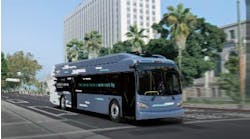Apr. 23—Making the Houston area's first foray into bus rapid transit a little less rapid might require a rethink before Metropolitan Transit Authority officials reduce service on the Silver Line to every 20 minutes.
With Metro's board scheduled to approve quarterly changes to bus service in the region on Thursday, Metro staff are making sure reducing service on the line doesn't jeopardize federal agreements related to the $192.5 million project by the Uptown Houston Management District.
"Uptown has contractual obligations to provide BRT," Metro board member Roberto Treviño said. "If we go to 20 minutes, that's not BRT. Are we ready to do that?"
Buses are now scheduled to arrive at each station every 12 minutes. Taking them to every 20 minutes would free up buses now used to maintain that pace, but it would also mean the line does not meet the federal standard for rapid transit. The Federal Transit Administration considers rapid transit something where buses come every 15 minutes or less.
Uptown Houston officials and Metro are working to understand the implications of the change.
"The potential impact of Metro's reduction of service frequency of the Silver Line on the FTA grant, if it is passed, is currently unknown," Uptown officials said in a statement.
The line, which opened in August 2020, uses dedicated lanes along Post Oak and a busway parallel to Loop 610 to connect the Northwest Transit Center near Interstate 10 to the Westpark Lower Uptown Transit Center along Westpark Drive. The management district rebuilt Post Oak, and Metro agreed to operate the buses. Funding came from local property tax revenues captured by the management district for capital projects and Federal Transit Administration money doled out by the Houston-Galveston Area Council's Transportation Policy Council.
Since opening during the pandemic, however, use of the Silver Line has languished. Daily average use only broke 1,000 passengers for the first time in January. After more than 40 months of operation, during which the buses have made some 20,000 round trips along the route, only 11 times has a bus been at full capacity, Jim Archer, director of service planning and scheduling for Metro, told board members.
Critics, who predicted the line would be a failure long before it was opened, have pounced on the poor ridership in recent calls to slow Metro's other long-term transit plans.
Metro, meanwhile, is adjusting to changes in travel patterns and its ongoing efforts to replace an aging bus fleet. As part of service changes, planned every three months, Metro officials proposed in March to change the Silver Line from buses arriving every 12 minutes as they do now to coming every 20 minutes.
"There is a balance we are trying to achieve," Metro interim CEO Tom Jasien said, noting the ridership for the rapid line "is just not there."
The change allows for Metro to use about four of the 14 60-foot articulated buses operating the route now along other Metro bus lines, where during certain times of day the bigger buses are needed.
Precisely where the buses can be used would be evaluated later, officials said, after signs are changed on the buses. Some major routes, however, are unlikely to see the larger vehicles, namely the Route 82 Westheimer — the most used bus route not only in Houston but the state of Texas. As a result of curves along Westheimer and the narrow condition of the street, Metro cannot safely run articulated buses on the route.
On Thursday, officials will have to decide if they want to shift the buses away from the Silver Line and reduce the line to non-rapid service, or find some in-between that allows for 15-minute arrivals to keep the rapid standard, but commit buses needed elsewhere to do so.
"We will do whatever the board directs," Archer said when officials asked if 15 minutes instead of 20 could work. "It does not change the ridership situation we are facing on the BRT."
___
(c)2024 the Houston Chronicle
Visit the Houston Chronicle at www.chron.com
Distributed by Tribune Content Agency, LLC.


